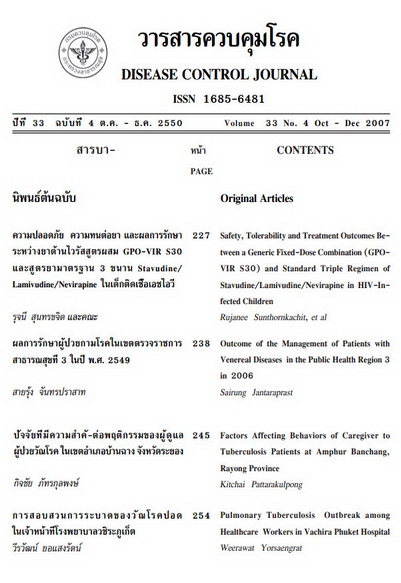Risk Factors for Mortality of Bacteremia in Surin Hospital
Keywords:
Bacteremia, Risk factor, mortalityAbstract
Bacteremia presented clinical manifestation as sepsis, severe sepsis or septic shock was the common problem and resulted in high mortality rate. The objectives of this study were to study the relationship between risk factors and mortality and to set up the guideline for treatment to decrease mortality rate in bacteremic patient. A retrospective analytical study was performed in 116 bacteremic patients in Surin hospital during 1st July 2006 to 30nd June 2007. Data was collected from patient' s medical records. The risk factors in this study were sex, age, underlying disease, community acquired or nosocomial infection, sepsis, severe sepsis, septic shock, site of infection, pior of antibiotic treatment, adequate or inadequate antibiotic treatment and organism of bacteria from hemoculture mortality. The data was analyzed by univariate analysis and multiple logistic regression analysis. The results of the study revealed that the risk factors associated with mortality of which were statistically significant were age more than 50 year (OR 3.91 95%CI 1.04-14.68, P < 0.044) septic shock (OR 28.14 95%CI 6.12-102.57, P < 0.004) pior antibiotic treatment (OR 6.07 95%CI 1.88-19.62, P < 0.002) and inadequate antibiotic treatment (OR 37.75 95%CI 9.36-152.17, P < 0.001). Therefore the guideline for treatment to decrease mortality rate of bacteremic patient in Surin hospital were adequate antibiotic treatment, early empirical appropriate antibiotic treatment and antibiotic guideline and early gold directed therapy.
Downloads
References
2. Martin GS, Mannino DM, Eaton S, Moss M. The epidemiology of sepsis in the United States from 1979 through 2000. N Engl J Med. 2003; 348: 1546-54
3. Rangle-Frausto MS, Pittet D, Hwang T, Woolson RF, Wenzel RP. The dynamics of disease progression in sepsis : Markov modeling describing the natural history and the likely impact of effective antisepsis agents. Clin Inec Dis. 1998;
27: 185-90
4. อมร ลีลารัศมี. ภาวะเส็พสิส. ใน : พรรณพิศ สุวรรณกูล. ศศิธร ลิขิตนุกูล. ธีระพงษ์ ตัณฑวิเชียร, บรรณาธิการ. An Update on Infectious Diseases. กรุงเทพฯ : สวิชาญการพิมพ์ ; 2548. 68-79
5. Kollef MH, Sherman G, Ward S, Fraser VJ. Inadequate antimicrobial treatment of infections a risk factor for hospital mortality among critically Ill patients. Chest. 1999; 115: 462-74
6. Annane D, Aegerter P, Jars-Gincestre MC, Guidet B. Current epidemiology of septic shock: the CUB-Rea Network. Am J Respir Crit Care Med. 2003; 1687: 165-72
7. Wilson ML (ed). Blood cultures. Clin Lab Med. 1994; 14: 102.
8. Washington JA II. Blood cultures: Issues and controversies. Rev Infect Dis. 1986; 8: 792-802
9. Geerdes HF, Ziegler D, Lode H, et al. Septicemia in 980 patients at a university hospital in Berlin : prospective studies during 4 selected years between 1979 and 1989. Clin infect Dis 1992; 15: 991-1002
10. Roberts FJ, Geere IW, Coldman A. A three-year study of positive blood cultures, with emphasis on prognosis. Rev infect Dis 1991; 13: 34-46
11. Brun-Buisson C, Doyon F, Carlet J. Bacteremia and severe sepsis in adults : a multicenter prospective survey in ICUs and wards of 24 hospitals. French Bacteremia-Sepsis Study Group. Am J Respir Crit Car Med. 1996 : 154: 617-24
12. Weinstein MP, Towns ML, Quartey SM, et al. The clinical significance of positive blood cultures in the 1990s: a prospective comprehensive evaluation of the microbiology, epidemiology, and outcome of bacteremia and fungemia in
adults. Clin Infect Dis. 1997; 24: 584-602
13. Valles J, Rello J, Ochagavia A, Garnacho J, Alcala MA. Community-aquired bloodstream infection in critically III adult patients impact of shock and inappropriate antibiotic therapy on survival. Chest. 2003; 123: 1615-24
14. Revers E, Nguyen B, Havstad S, Ressler J, Muzzin A, Knoblich B, et al. Early goal -directed therapy in the treatment of severe sepsis and septic shock. N Engl J Med. 2001; 345: 1368-77
15. พรพิศ ตรีบุพชาติสกุล, นาตยา คำสว่าง, ปัญญา เถื่อนด้วง. ผลการรักษาผู้ป่วยติดเชื้อในกระแสเลือดหลังใช้แนวทางเวชปฏิบัติ. พุทธชินราชเวชสาร 2550; 24(1): 33-45
16. Ibrahim EH, Sherman G, Ward S, Fraser VJ, Kollef MH. The influence of inadequate antimicrobial treatment of bloodstream infections on patient outcomes in the ICU setting. Chest 2000; 118:1 46-55
17. Garnacho-Montero J, Garcia-Garmendia JL, Barrero-Almodovar a. Impact of adequate empirical antibiotic therapy on the outcome of patients admitted to the intensive care unit with sepsis. Crit Care Med 2003; 31: 2742-51
18. MacArthur RD, Miller M, Alberson T. Adequacy of early empiric antibiotic treatment and survival in severe sepsis : experience from the MONARCS trial. Clin Infect Dis 2004; 38: 284-8
Downloads
Published
How to Cite
Issue
Section
License
Articles published in the Disease Control Journal are considered as academic work, research or analysis of the personal opinion of the authors, not the opinion of the Thailand Department of Disease Control or editorial team. The authors must be responsible for their articles.


.png)



